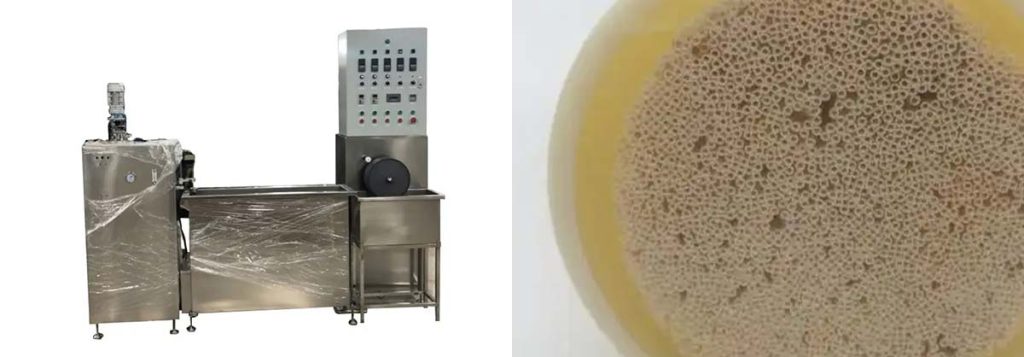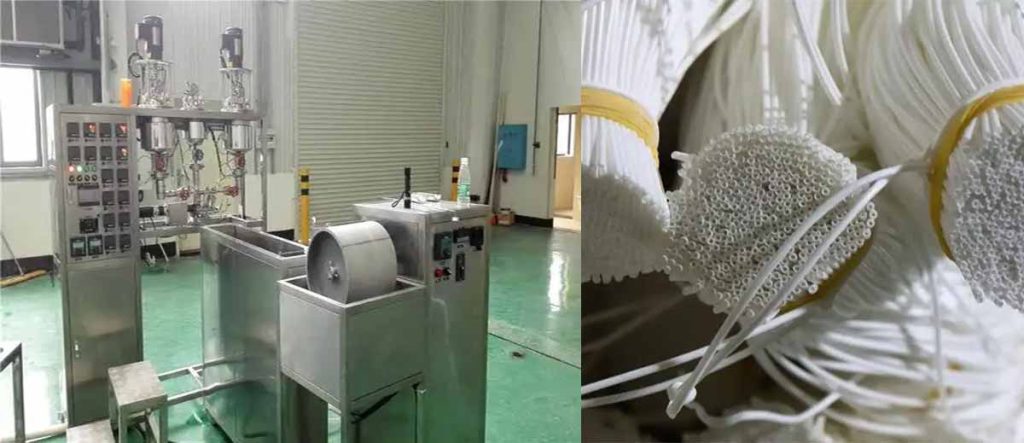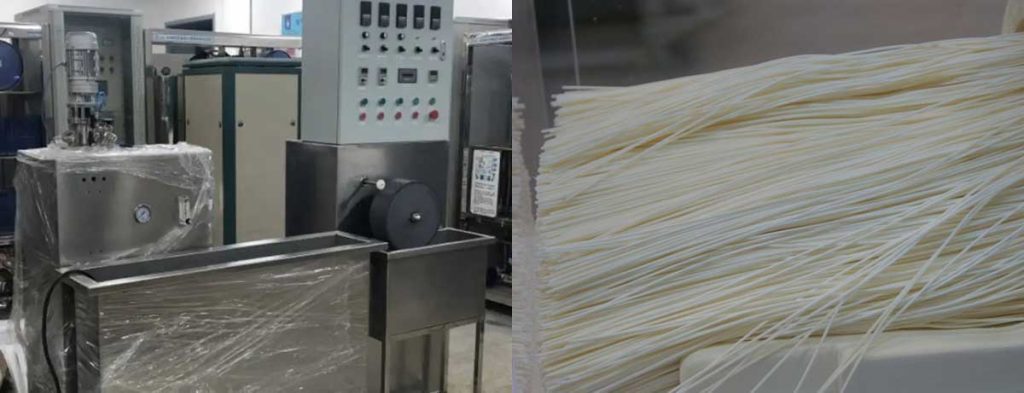

Testing the quality of a hydrophilic PVDF membrane requires careful evaluation of hydrophilicity, permeability, pore integrity, retention, and mechanical strength. Many PVDF membrane applications face persistent challenges:
- Membrane fouling lowers filtration efficiency and increases maintenance.
- Durability issues lead to reduced lifespan, especially under harsh conditions.
- High production costs and environmental concerns stem from complex synthesis and solvent use.
- The trade-off between selectivity and permeability complicates performance.
Manufacturers often use a hollow fiber spinning machine and a hollow fiber spinneret to optimize polyvinylidene fluoride membrane structure. Reliable membrane testing ensures each hydrophilic PVDF membrane meets critical performance demands, with hydrophilicity remaining a primary focus throughout all PVDF membrane testing steps.
Key Takeaways
- Testing hydrophilicity using water contact angle helps ensure membranes absorb water well, improving filtration and reducing fouling.
- Measuring water absorption and permeability guides manufacturers to balance membrane thickness and pore structure for optimal performance.
- Mechanical strength tests confirm membranes can withstand pressure and cleaning without damage, extending their lifespan.
- Integrity tests like the bubble point and visual inspections detect defects to guarantee reliable filtration and consistent membrane quality.
- Chemical resistance and extractables testing protect membrane safety and durability, especially in harsh or sensitive applications.
Membrane Characterization
Membrane characterization forms the foundation of quality assessment for hydrophilic PVDF membrane. This process involves a series of laboratory and industrial tests that evaluate the membrane surface, permeability, hydrophilicity, and mechanical strength. Manufacturers rely on advanced equipment, such as the hollow fiber spinning machine and hollow fiber spinneret, to produce polyvinylidene fluoride membranes with consistent properties. The following sections outline the most important testing methods for membrane characterization.
Static Water Contact Angle
The static water contact angle (WCA) provides a direct measurement of hydrophilicity on the membrane surface. Lower contact angles indicate higher hydrophilicity, which is essential for efficient water transport and reduced fouling. Pristine PVDF membranes typically show a high contact angle, around 120°, reflecting their hydrophobic nature. Hydrophilic modification reduces this value, with high-quality hydrophilic PVDF membrane displaying contact angles between 60° and 85°.
Surfaces with a contact angle below 90° are considered hydrophilic, while those above 90° are hydrophobic. Hydrophilic modification, such as blending with additives or surface grafting, can lower the contact angle by up to 30°, significantly improving wettability.
The following table compares static water contact angles for various membrane types:
| Membrane Type | Static Water Contact Angle (°) | Notes |
|---|---|---|
| Hydrophilic PVDF (high β-phase) | ~87.2 | Lower contact angle due to β-phase polymorphs promoting water interaction |
| Cellulose Triacetate (CTA) | 64.0 (untreated) to 37.1 (plasma treated) | Plasma treatment significantly reduces contact angle, increasing hydrophilicity |
| Modified PVDF with TA and PVP | 49.0 (lowest reported) | Chemical modification with additives greatly enhances hydrophilicity |
| Typical hydrophobic PVDF | >87.2 | Higher contact angle due to hydrophobic nature |
Hydrophilic modification, such as the addition of tannic acid (TA) and polyvinylpyrrolidone (PVP), can reduce the static water contact angle to as low as 49°, indicating a highly hydrophilic membrane surface. This improvement in hydrophilicity directly enhances permeability and filtration performance.
Water Absorption
Water absorption, often measured as the water uptake rate (WUR), reflects the membrane’s ability to interact with water molecules. Hydrophilic PVDF membrane with higher water absorption rates demonstrate improved permeability and antifouling properties. The addition of hydrophilic additives, such as triethanolamine (TEA) and polyethylene glycol (PEG), increases both water absorption and porosity.
| Membrane Type | Additives (TEA:PEG) | Water Uptake Rate (WUR) | Water Contact Angle (WCA) | Porosity (%) | Thickness (cm) | Permeability (N/A2) | Dye Rejection (%) | Water Flux (LMH) |
|---|---|---|---|---|---|---|---|---|
| M0 (pure PVDF) | None | 30% | 86° | 11.3 | 0.0203 | 21.2 | – | – |
| M1 | TEA | 53.8% | 82° | – | – | 20.2 | – | – |
| M2 | TEA:PEG (1:1) | 57.5% | 78° | 30.8 | 0.0224 | 18.5 | >97.3 (dye) | 100 |
| M3 | Increased PEG | 60.3% | 97° | 40.5 | 0.0165 | 41.1 | – | – |
| M4 | Further increased PEG | 68.5% | 101° | 40.5 | 0.0220 | 24.6 | – | – |
A balanced hydrophilic modification, as seen in the M2 membrane, achieves optimal hydrophilicity and permeability, resulting in high dye rejection and water flux. Excessive additives may increase water absorption but can negatively affect permeability due to changes in membrane thickness and pore structure. Testing water absorption helps manufacturers optimize the polyvinylidene fluoride membrane for specific filtration applications.
Mechanical Properties
Mechanical strength is critical for the durability and operational stability of hydrophilic PVDF membrane. Tensile strength testing remains the most relevant method for evaluating mechanical properties. Membranes with higher tensile strength withstand operational pressures and repeated cleaning cycles without damage.
The addition of natural additives, such as ginger extract, can enhance the tensile strength of polyvinylidene fluoride membranes by reinforcing the polymer matrix. This improvement ensures the membrane maintains its structure during filtration.
Post-fabrication treatments, such as PVA blending and cross-linking, further improve mechanical strength. Dip-coating the membrane surface with polyvinyl alcohol (PVA) and cross-linking with glutaraldehyde and sulfuric acid forms strong acetal bonds. This process creates a robust hydrophilic active layer on the PVDF support, increasing both hydrophilicity and mechanical integrity. The optimal number of PVA layers balances these properties, as confirmed by FTIR and SEM analysis.
Superhydrophilic modification, such as blending with polyethyleneimine (PEI) or coating with phytic acid, primarily targets the membrane surface to enhance hydrophilicity and antifouling performance. While these modifications improve wettability and separation efficiency, their direct impact on mechanical strength is less pronounced compared to PVA blending.
Common Laboratory and Industrial Testing Methods
- Differential scanning calorimetry (DSC) for thermal behavior analysis
- Field emission scanning electron microscopy (FE-SEM) for surface and cross-sectional morphology
- Mercury porosimetry for macro-porosity and pore size distribution
- Atomic force microscopy (AFM) for surface roughness
- Dynamic contact angle measurements for hydrophilicity
- Crossflow filtration system for membrane performance
- Tensile strength testing with a tensiometer
These methods, combined with careful control of the hollow fiber spinning machine and hollow fiber spinneret during manufacturing, ensure that each polyvinylidene fluoride membrane meets the required standards for hydrophilicity, permeability, and mechanical strength. Membrane characterization remains essential for optimizing both the membrane surface and overall performance in demanding filtration environments.
Hydrophilic PVDF Membrane Integrity
Ensuring the integrity of a hydrophilic PVDF membrane is essential for reliable filtration performance. Integrity testing focuses on detecting defects, verifying pore structure, and confirming that the membrane surface meets application requirements. Manufacturers use both laboratory and industrial methods to assess the quality of each PVDF membrane, especially when produced with a hollow fiber spinning machine and hollow fiber spinneret. Two primary approaches—bubble point testing and visual inspection—provide a comprehensive evaluation of membrane structure and function.
Bubble Point Test
The bubble point test remains a standard method for assessing the largest pore size and overall integrity of a hydrophilic PVDF membrane. This testing process involves applying gas pressure to a wetted membrane until gas displaces the liquid from the pores. The pressure at which a sudden increase in gas flow occurs marks the bubble point, which directly relates to the largest pore diameter present in the membrane structure.
- The principle of the bubble point test relies on the relationship between applied pressure and pore size. The equation P = 4kσcosθ / d describes this relationship, where P is the bubble point pressure, k is the pore shape factor, σ is the liquid surface tension, θ is the wetting angle, and d is the pore diameter.
- Below the bubble point, gas diffuses through liquid-filled pores. Above this threshold, gas flows freely as the largest pores empty.
- Operators increase the pressure gradually and monitor for a sharp rise in flow rate, which signals the evacuation of the largest pore.
- A membrane that shows a very high flow rate at pressures below the expected bubble point may have gross leaks or invalid test results, leading to failure.
- The bubble point test alone does not always detect all defects. Filters with small holes or irregularities may still pass, so manufacturers often combine this test with other integrity assessments.
Note: Automated integrity test (AIT) systems use proprietary algorithms to interpret bubble point data. These systems help standardize testing but may lack transparency regarding pass/fail thresholds.
The bubble point test provides indirect assurance of retention capability. It remains a critical step in the quality control of PVDF membranes, especially for applications requiring precise pore size distribution and reliable separation.
Visual And Physical Inspection

Visual and physical inspection methods complement bubble point testing by providing direct evidence of membrane surface quality and membrane structure. These inspections help identify physical defects, irregularities, and inconsistencies that may compromise performance.
- Scanning Electron Microscopy (SEM) offers detailed visualization of the membrane surface and cross-sectional morphology. SEM images reveal pore size, distribution, and the presence of defects such as cracks or pinholes.
- Atomic Force Microscopy (AFM) assesses the topography and mechanical properties of the membrane surface. AFM can detect subtle irregularities and variations in membrane structure that may not appear in SEM images.
- Focused Ion Beam-Scanning Electron Microscopy (FIB-SEM) enables analysis of nanoparticle distribution within the membrane structure at various depths. This technique provides a three-dimensional view of pore connectivity and uniformity.
Manufacturers often use these advanced microscopy techniques during quality control, especially when optimizing the membrane structure with a hollow fiber spinning machine and hollow fiber spinneret. These tools ensure that each PVDF membrane meets strict standards for pore uniformity and surface integrity.
Tip: Combining SEM and AFM inspections with performance testing offers a comprehensive approach to membrane quality assurance. These methods help detect both surface and subsurface defects, ensuring long-term reliability in demanding filtration environments.
Visual and physical inspection, together with bubble point testing, forms the backbone of PVDF membrane integrity assessment. These methods allow manufacturers to deliver membranes with consistent performance, robust membrane structure, and high-quality membrane surface properties.
Permeability and Flow Performance
Normalized Water Permeability
Normalized water permeability serves as a primary indicator of membrane permeability performance in hydrophilic PVDF membrane. This parameter measures the water flux through the membrane under standardized conditions, allowing direct comparison between different membrane samples. Testing normalized water permeability helps manufacturers evaluate the impact of fabrication variables, such as polymer concentration and the use of a hollow fiber spinning machine or hollow fiber spinneret, on membrane structure.
Membranes with lower polymer content, such as 15% PVDF, display higher normalized water permeability due to more open pore structures. In contrast, increasing the polymer concentration to 20% produces denser membranes with smaller pores, resulting in lower normalized water permeability. This structural difference directly affects membrane permeability performance and operational efficiency. Over time, long-term operational data from water treatment plants reveal that hydrophilic PVDF membrane maintains stable normalized water permeability for several years. However, after about five years, a decline in normalized water permeability occurs, often due to the loss of hydrophilic additives and increased exposure to cleaning chemicals. This decline signals reduced membrane permeability performance and overall membrane flux.
Surface modification, such as poly(ionic liquid) functionalization, can enhance antifouling properties and improve normalized water permeability. These modifications help maintain high membrane flux and stable membrane permeability performance, even during extended fouling tests.
Low-Pressure Filtration Test
The low-pressure filtration test simulates real-world operational conditions for hydrophilic PVDF membrane. This testing method measures membrane flux and permeability at pressures similar to those found in industrial filtration systems. Operators use this test to assess how the membrane responds to sustained filtration cycles and to identify any decline in membrane permeability performance over time.
During the test, water passes through the membrane at a controlled low pressure. The resulting membrane flux and normalized water permeability provide insight into the membrane’s ability to maintain high performance under typical working conditions. Consistent results in this test indicate robust membrane permeability performance and durability. Repeated low-pressure filtration testing also helps detect early signs of fouling or structural degradation, which can result from improper use of the hollow fiber spinning machine or hollow fiber spinneret during manufacturing.
Tip: Regular low-pressure filtration testing ensures that each PVDF membrane delivers reliable membrane flux and maintains optimal permeability throughout its service life.
Retention and Binding Tests
Retention Efficiency
Retention efficiency stands as a critical indicator of pvdf membrane performance in filtration applications. Operators often evaluate this property by conducting filtration tests that measure the rejection rates of target substances, such as total suspended solids (TSS), turbidity, and proteins like BSA. High-quality pvdf membranes consistently achieve rejection rates above 96% for TSS and nearly 99% for turbidity. These results demonstrate strong retention of suspended particles and contribute to superior antifouling performance.
To further assess retention, technicians use the gravimetric method to determine porosity. They weigh the membrane in both dry and wet states, then calculate porosity to understand how the structure influences retention. The Guerout-Elford-Ferry equation allows calculation of the mean pore radius, using porosity, membrane thickness, water viscosity, permeate flux, and operating pressure. This comprehensive approach ensures that each pvdf membrane, especially those produced with a hollow fiber spinning machine and hollow fiber spinneret, meets strict performance standards.
Note: High retention efficiency not only improves water quality but also enhances antifouling performance, reducing maintenance and extending membrane lifespan.
Protein Binding Capacity
Protein binding capacity plays a vital role in biotechnological applications, such as Western blotting and immunoblotting. Technicians measure this property by incubating proteins of various molecular weights—such as trypsin, fetuin, BSA, and lactase—onto activated pvdf membranes. After incubation, they stain the membrane and analyze signal intensity using image analysis software. Results show that pvdf membranes exhibit higher binding capacity for high molecular weight proteins, such as lactase, compared to nitrocellulose membranes. For medium molecular weight proteins like BSA, both membrane types perform similarly.
- Incubation typically uses protein concentrations from 40 to 2560 μg/500 μL for two hours.
- Staining and image analysis quantify the amount of protein bound to the membrane.
- GVS pvdf membranes report a BSA binding capacity of approximately 125 µg/cm².
The hydrophobic nature of pvdf membranes, combined with their chemical compatibility and low extractables, ensures reliable results and exceptional sensitivity. Consistent lot-to-lot quality checks further guarantee dependable protein binding and stable antifouling performance. The use of a hollow fiber spinning machine and hollow fiber spinneret during manufacturing supports uniform membrane structure, which is essential for reproducible protein binding and overall membrane performance.
Chemical Compatibility and Extractables
Chemical Resistance
Hydrophilic pvdf membrane must withstands a wide range of chemicals during filtration processes. Operators often expose these membranes to acids, bases, solvents, and oxidizing agents. The pvdf polymer structure provides strong resistance to most chemicals, making it suitable for harsh environments. Many laboratories test chemical compatibility by immersing the membrane in various solutions and observing changes in appearance, weight, or mechanical strength.
A pvdf membrane typically resists degradation from common cleaning agents, such as sodium hypochlorite and hydrogen peroxide. However, strong alkalis or concentrated acids may cause some swelling or minor loss of mechanical properties. The hollow fiber spinning machine and hollow fiber spinneret play a crucial role in producing membranes with uniform chemical resistance. Consistent fabrication ensures that each pvdf membrane maintains its integrity during repeated exposure to challenging chemicals.
Tip: Regular chemical resistance testing helps identify early signs of membrane degradation, supporting long-term reliability in industrial and laboratory settings.
Extractables and Leachables
Understanding extractables and leachables is essential for ensuring the safety and performance of hydrophilic pvdf membrane. Extractables refer to compounds that migrate from the membrane under exaggerated test conditions, while leachables are compounds that migrate under normal process conditions. Both can impact product purity, especially in pharmaceutical or bioprocessing applications.
The most significant extractables found in hydrophilic pvdf membrane include:
- Oligomers of the acrylate copolymer used for surface modification
- Traces of fatty acids
- Antioxidants from polypropylene resin additives
- Breakdown products of the acrylate copolymer
Technicians use several analytical methods to quantify these substances:
- Fourier-transform infrared (FTIR) analysis for nonvolatile residues
- Gas chromatography (GC) and high-performance liquid chromatography (HPLC) for volatile and semi-volatile compounds
- Ion chromatography for ionic species
- Inductively coupled plasma mass spectrometry (ICP-MS) for elemental analysis
Testing often uses water and ethanol as model solvents. Ethanol extracts show higher concentrations of extractables, ranging from 0.1 ppm to 3 ppm, with nonvolatile residues averaging 56 mg. The high surface area of the pvdf membrane, especially when produced with a hollow fiber spinning machine and hollow fiber spinneret, increases the potential for extractable migration.
A comprehensive extractables profile supports risk assessment and process qualification. The multi-technique approach detects compounds down to parts-per-billion levels, ensuring that pvdf membranes meet strict safety and quality standards.

Conclusion
Comprehensive testing of hydrophilic pvdf membrane requires a focus on hydrophilicity, permeability, modification, and antifouling performance. Key tests—such as contact angle, permeability, and retention—ensure each pvdf membrane delivers reliable performance. Comparative studies show that hydrophilic modification, like PVA coating, enhances hydrophilicity and permeability, narrowing the gap with α-Al2O3 membranes.
| Performance Aspect | Hydrophilic PVDF Membrane | α-Al2O3 Membrane | Key Takeaway |
|---|---|---|---|
| Transmembrane Pressure (TMPn) | Higher (~1.2 at 40 LMH), less stable | Lower (~1.05 at 40 LMH), more stable | α-Al2O3 membranes have lower and more stable TMPn, indicating better fouling resistance. |
| Optimum Permeate Flux | 40 LMH | 60 LMH | α-Al2O3 membranes operate effectively at higher flux, suggesting superior performance. |
| COD Rejection | 99.8% | 99.8% | Both membranes achieve highly efficient COD removal. |
Manufacturers should optimize modification processes and maintain strict control over hollow fiber spinning machine and hollow fiber spinneret. This approach ensures consistent hydrophilicity, robust permeability, and minimal extractables, supporting long-term pvdf membrane reliability and antifouling performance.
